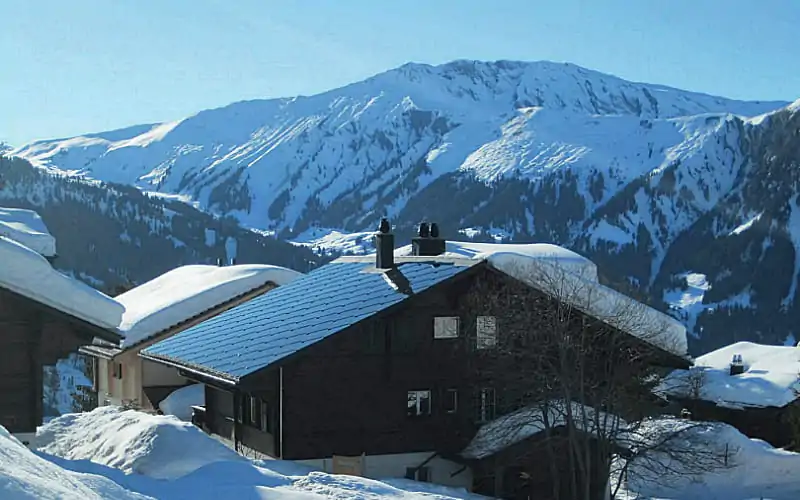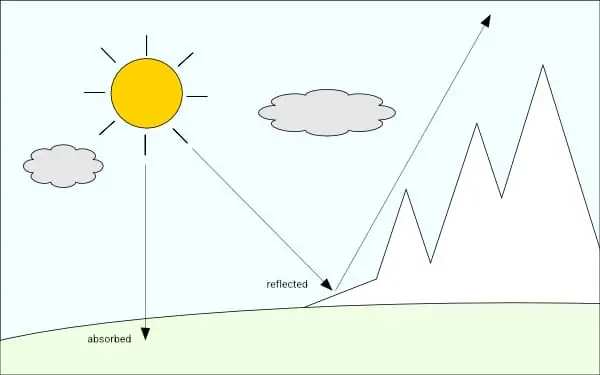Shorter days, less sunshine and snow-covered photovoltaic systems. It is obvious that less solar power can be generated in winter. But how much less? When designing your solar installation, a compromise must be found that takes all seasons into account.
In this article we explain all the details that need to be considered for photovoltaics in winter. After all, the dimensioning can vary depending on the intention. Furthermore, there are some tips that can help you through the colder season.

Do solar systems need direct sunlight?
First of all, it should be said that low temperatures in winter do not have a negative impact on electricity generation. On the contrary, the efficiency of a PV system actually increases at low temperatures. The warmer solar cells become, the lower the open-circuit voltage at the same current. Therefore, heated solar cells can deliver less power. At a module temperature of 60 degrees, the efficiency already drops to 80%. The reduction in voltage comes from the smaller “band gap” of the charge carriers in the semiconductor as the heat increases. The energy in the crystal lattice increases and so the energy difference in the semiconductor becomes smaller, which causes a lower open-circuit voltage.
Cold therefore has no negative influence. The amount of electricity produced depends on sunlight. But even that is limited in the winter months; on the one hand, the length of the sunshine hours is reduced, and on the other hand, the sky is often cloudy in autumn and winter. Fortunately, solar systems generate electricity even without direct sunlight. However, on cloudy days the yield is significantly reduced to 10 to 25%.
PV system: Dimensioning and economic consideration
Due to the variable yield, the purpose for which the solar system is to be installed must already be taken into account during planning. For example, if full self-sufficiency is to be achieved, the system must be designed large enough to supply enough energy even in winter. However, this means that a lot of electricity is overproduced in summer. Although the Renewable Energy Sources Act (EEG) allows every operator of a photovoltaic system to feed overproduced electricity into the public grid, the remuneration is not economically worthwhile.
Size
Storing electrical energy over long periods of time is still a big challenge. Therefore, the capacity of your own solar system should rather be somewhat larger so that you still have enough energy available in the cold months. Due to the seasons, you may have to make compromises here. Do you want to achieve complete self-sufficiency with your system? Then you should dimension your system so that you can at least supply the most important systems with electricity on cloudy winter days. You can then simply charge your electric car on a sunny day. If you want to achieve economic efficiency above all, then your PV system should be dimensioned so that it covers your needs in summer, but does not overproduce electricity. In winter, the photovoltaic system can at least cover part of your needs.
A new approach can also help here. Through a photovoltaic cloud, the overproduced electricity can be fed into the grid in summer. This means that you are credited for every kilowatt hour you feed into the grid. However, you do not receive any refund, but the amount of energy is recorded for the future. If the photovoltaic system then produces too little electricity in winter, the credited electricity can be used to make up the difference.
Location & Orientation
Of course, with photovoltaics in winter it also depends on the location. Depending on the canton, moderate to heavy snow falls in winter. That’s why we experimented with different angles of attack for the PV systems. To determine which angle performed best and when. It was discovered that for photovoltaics in winter, an angle of attack of 60 degrees is superior to the classic 35 degrees. On the one hand, this is due to the low angle of the sun, and on the other hand, snow does not adhere well to the modules. In the annual balance, however, 35 degrees is still superior, depending on the location. Except in the alpine region, where 35 and 60 degrees share first place.
On the website of the Swiss Federal Office of Energy (SFOE), you can find out how much electricity your roof can produce based on your location.
Alpine power generation
In general, the yield of photovoltaics in winter increases drastically in alpine regions compared to the midlands. So much in fact, that overall electricity production is also highest in the mountains.
The Bergloge Restaurant Ristis in Engelberg decided to equip its roof with SunStyle solar tiles. The photovoltaic system supplies enough energy, even in winter, so that the building is now completely climate-neutral.
What aspects need to be taken into account for photovoltaics in winter?
The things you need to consider for photovoltaics in winter are mainly relevant during planning. Let experts advise you here. Things like frost protection and bearing load must be calculated for the solar roof so that the system does not suffer any damage in winter. It is important that you know how much power your photovoltaic system produces in winter and summer. This will enable you to better weigh up the size of the system.
Is it necessary to clear PV systems of snow?
If the solar system is covered with snow in winter, it produces considerably less electricity. For this reason, many photovoltaic owners want to get the snow off the roof. However, caution is advised. Climbing on the snow-covered roof is dangerous and can quickly lead to an accident, so it is not advisable. In addition, the solar system is usually covered with snow when there would only be low yields anyway due to a lower position of the sun.
Are there performance losses?
As a result, the loss of power due to snow-covered photovoltaics in winter is only around five to eight percent for locations around 1000 metres above sea level and even only around one to four percent below 1000 metres above sea level. Photovoltaics in winter generate about one third of the total output of the system. This cannot be significantly increased by cleaning the roof. For the annual output, a snow-covered solar roof is therefore of little importance. However, an accident during cleaning can quickly increase the price per kWh immeasurably.
Advantages for photovoltaic systems in winter?
There are also advantages for photovoltaics in winter.
Snow-covered surfaces reflect sunlight, which can increase electricity production (albedo effect). In addition, the efficiency of the system increases due to cooler temperatures.
These factors ensure that, especially in alpine areas, even more electricity can be produced in the winter months.

Advantages of SunStyle products
Photovoltaics in winter must withstand the elements. SunStyle solar tiles act as a roof and are more resistant than conventional roof tiles due to the use of high-quality materials.
In winter, high pressure loads can occur due to snow masses on the roof. These can damage the roof and PV modules. A solar roof from SunStyle can withstand pressure loads above average, possible here are 5400 N/m² for a normal roof and 15400 N/m² with Alpine battening.
In addition, the frameless design allows snow to slide off better and no leaves or anything similar get caught in the construction. As a result, you will have to clean the roof less often. Of course, aesthetics also play a role in your house. With SunStyle, you maintain the homogeneous appearance of your house. The solar roof gives every building a modern touch, which can also be stylishly combined with traditional buildings.
All in all, solar tiles are currently the best solution if you want to benefit from renewable energies and enhance the design of your house.
Do you have further questions regarding photovoltaics in winter, or do you have a project you need help with? Then contact us, we will be happy to assist you with individual advice.
For more information about SunStyle’s solar roof, visit sunstyle.com
Power your interest in the future of solar roofing by following us:
Instagram @sunstyle_solar
Facebook @sunstylesolar
LinkedIn linkedin.com/company/sunstylesolar
Youtube @youtube channel


